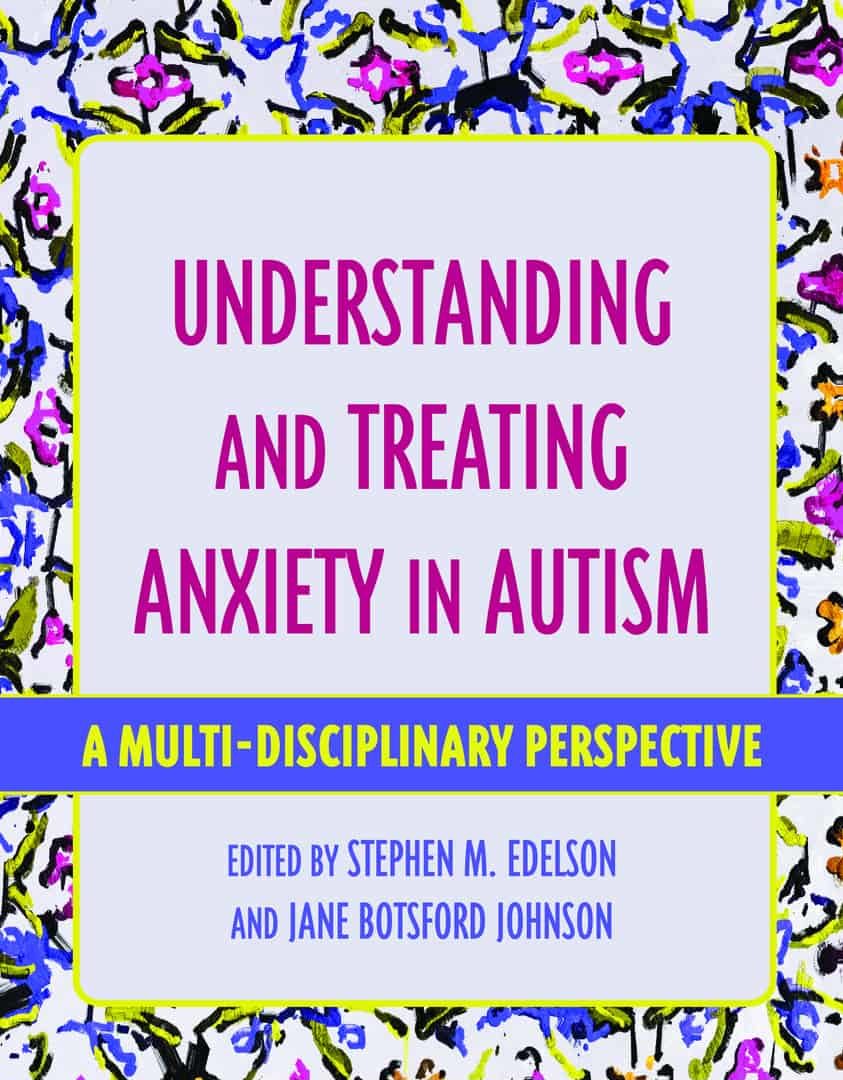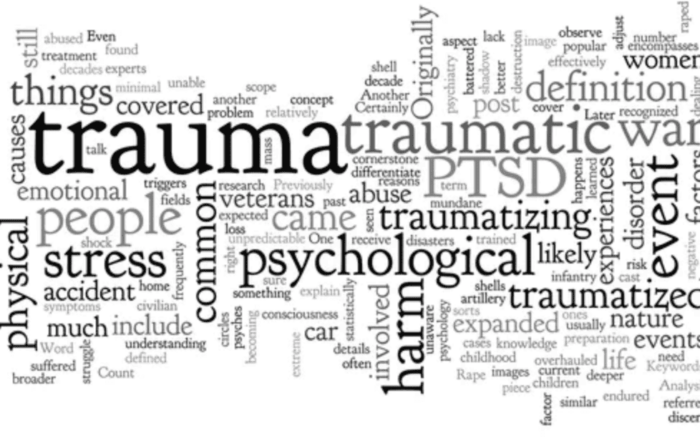Anxiety disorders are among the common comorbidities of autism spectrum disorder. The reason for this overlap is still under investigation. However, several treatments for anxiety may deliver positive results for people with both anxiety and autism spectrum disorder.
What is anxiety?
Anxiety is an emotion marked by heightened alertness. This emotion is a natural response to a threat or stressor. When the symptoms persist after the stressor is removed, or when the anxiety response becomes chronic, this may indicate an anxiety disorder.

A new book, titled Understanding and Treating Anxiety in Autism, is now available from Jessica Kingsley Publishers. The book is edited by ARI’s executive director, Stephen M. Edelson, and past ARI Board member, Jane B. Johnson, and consists of chapters written by leading experts in the autism field. Understanding and Treating Anxiety in Autism summarizes the current perspectives and research on anxiety in autism including neurology, medical, immunology, gastrointestinal, nutrition, sensory, and behavioral. Learn more
Common symptoms of anxiety disorders include:
- feelings of fear or doom
- restlessness
- increased heart rate
- difficulty concentrating
- muscle tension
- Irritability
- changes in appetite
- sleep disturbance
Several of these symptoms overlap with common symptoms of autism. These include repetitive behavior, the rigidity of routine, rituals, flat affect, or limited social interactions. The overlap can make it more difficult to identify anxiety disorders in people who already have an autism diagnosis.
How common is anxiety?
Anxiety disorders are the most common mental disorder in the United States, affecting about 18% of the general population. Research has shown that the incidence of anxiety in people with autism may be significantly higher than in the general population. One systematic review of the published research on anxiety and autism found that almost 40% of children with autism and 50% of adults with autism experience some sort of anxiety disorder (Van Steensel, 2011). Adolescents and school-age children with autism have the highest prevalence of clinical (40%) and subclinical anxiety (26%) compared to other age groups with autism. This mirrors patterns found in the general population.
Specific phobias are the most common form of anxiety disorder among people with autism. A person with a phobia experiences extreme distress when exposed to a specific stimulus or situation. Obsessive-Compulsive disorder and social anxiety disorder also occur frequently.
Anxiety and autism can interact in ways that intensify the challenges for a person living with these disorders. The symptoms of autism may make anxiety more challenging to manage. At the same time, the symptoms of anxiety may create barriers for a person with autism as they work with clinicians and therapists, interact with friends and family, and pursue personal or professional goals.
Why are rates of anxiety higher in people with autism?
Although the research above has shown that anxiety is more common in people with autism, researchers are still exploring why this is the case. Each individual may experience the overlap between anxiety and autism differently depending on their personal combination of symptoms and skills.
In the webinar Anxiety, Autism: Five Prime Suspects, Christopher Lynch, Ph.D., explores five ways that anxiety and autism may interact.
- Attention to detail. People with autism tend to be more detail-focused. While this can be a valuable skill, it can also make transitions and changes in routine more challenging. When a person with autism, especially a child, is forced to shift their attention before they are ready, anxiety may result.
- Sensory sensitivities. Some individuals with autism experience noise, touch, sight, smell, taste, temperature, pain and other sensory factors more intensely. Overwhelming sensory sensations can lead to sensory overload, which can trigger anxiety.
- Social situations. Increased sensory load and pressure to work within often unspoken social rules can increase anxiety in people with autism. A twin study reported by Spectrum News identified a link between high intelligence and social anxiety in autism. “It’s likely that some of these children’s worries stem from their acute awareness of their difficulties,” the article stated.
- Language. Some individuals with autism process language differently. Anxiety may increase when they find it difficult to express their wants or needs or when others fail to understand them.
- Task frustration. People whose autism symptoms include differences in motor skills, executive function, or abstract thinking may feel anxiety when working on a challenging task.
Other possible explanations for the overlap between autism and anxiety include:
- Genetic factors. Anxiety and autism may have a shared genetic origin that researchers have yet to identify.
- Insufficient support. People with ASD may face challenges and have comorbidities that require additional support and resources. Worrying about, or being unable to access these resources, can increase anxiety.
- Social pressures. The stress of living in a world that expects individuals to act or interact in ways that don’t feel natural to them may intensify anxiety.
How to spot signs of anxiety
Both caregivers and people with autism should look out for signs of anxiety. Some symptoms of anxiety overlap with symptoms of autism. This can make anxiety more difficult to identify in a person with autism.
A person experiencing anxiety may lose their appetite or eat more than normal. They may struggle to fall asleep or stay asleep. Sometimes, anxiety can look a lot like anger or fear. Stay alert to changes over time to help you decide whether this is a passing mood or a long-term condition.
You may notice an increase in repetitive or compulsive behaviors or an increase in sensory sensation-seeking behaviors. These behaviors may represent an attempt to decrease or manage anxiety.
It can be helpful to keep a journal to track behaviors and moods. A written record is more reliable than casual observations and memory. Notice changes in sleep, appetite, excitement over special interests, and overall daily mood.
If you or someone you care for is experiencing anxieties, talk to your clinician. They may be able to recommend strategies or treatments to help manage anxiety. Your clinician may also refer you to a specialist or provide access to supportive resources.
Strategies to address anxiety
Work with your clinician to identify strategies and treatment options to address anxiety. Here are a few of the treatments and strategies your clinician may suggest:
- Remove the stressor or address the situation. For example, if a child is being bullied at school, this can lead to symptoms of anxiety. Addressing the bullying issue may help alleviate symptoms.
- Build new skills. Problem-solving strategies and coping skills can help people with anxiety to feel more in control and minimize anxiety, whether they have autism or not.
- Seek out accommodations. School and work accommodations can help people with autism manage symptoms of anxiety. Reducing sensory input and creating clear schedules or routines have both been shown to minimize anxiety.
- Psychological intervention. Modified Cognitive behavior therapy and Mindfulness-based strategies may a person with autism become more aware of thoughts and emotional responses, which can help them to address anxiety, including situations before they become overwhelming.
- Medication. In some cases, medication provided under close medical supervision can help control anxiety while the individual builds skills, sets up accommodations, or begins therapy. There is limited data on the use of anxiety medication for individuals with ASD.
Anxiety, much like depression, is a common comorbidity of autism. It is also treatable. If you notice changes in mood or behavior, you can talk to your doctor about possible interventions or treatments.
ARI thanks Amy Keefer, PhD, ABPP of the Kennedy Krieger Institute for her ARU webinar, which was the basis of this article. For more on anxiety and autism watch the presentation.
Supporting Positive Psychiatry
Free webinar at 1 p.m. Eastern time (US), Wednesday, September 25, 2024 About the speaker: Patricia Wright, PhD, MPH, is Executive Director of Proof Positive: Autism Wellbeing Alliance.
Blood-brain barrier dysfunction in Pediatric Acute Neuropsychiatric Syndrome (PANS) and Regulation
Free webinar at 1 p.m. Eastern time (US), Wednesday, May 29, 2024 Tune in to learn research updates on blood-brain barrier dysfunction in Pediatric Acute Neuropsychiatric Syndrome (PANS) and
“School distress” rates are elevated among those with autism
Rates of “school distress”—or significant emotional distress related to attending school—are significantly elevated in children with autism spectrum disorders (ASD), according to a new study from the United Kingdom. Sophie Connolly
“School distress” rates are elevated among those with autism
Rates of “school distress”—or significant emotional distress related to attending school—are significantly elevated in children with autism spectrum disorders (ASD), according to a new study from the United Kingdom.Sophie Connolly and colleagues
Sexual Victimization in Autism
In this article: Chronic maltreatment and sexual victimization Trauma and quality of life Risk Factors What can we do? A safer future Resources Despite evidence to the contrary, misperceptions of autistic
Stress and Anxiety Reduction with June Groden, Ph.D
Interview with June Groden, Ph.D. Dr. June Groden is considered one of the pioneers in the field of autism and developmental disabilities. Her primary areas of interest are stress and anxiety and procedures






